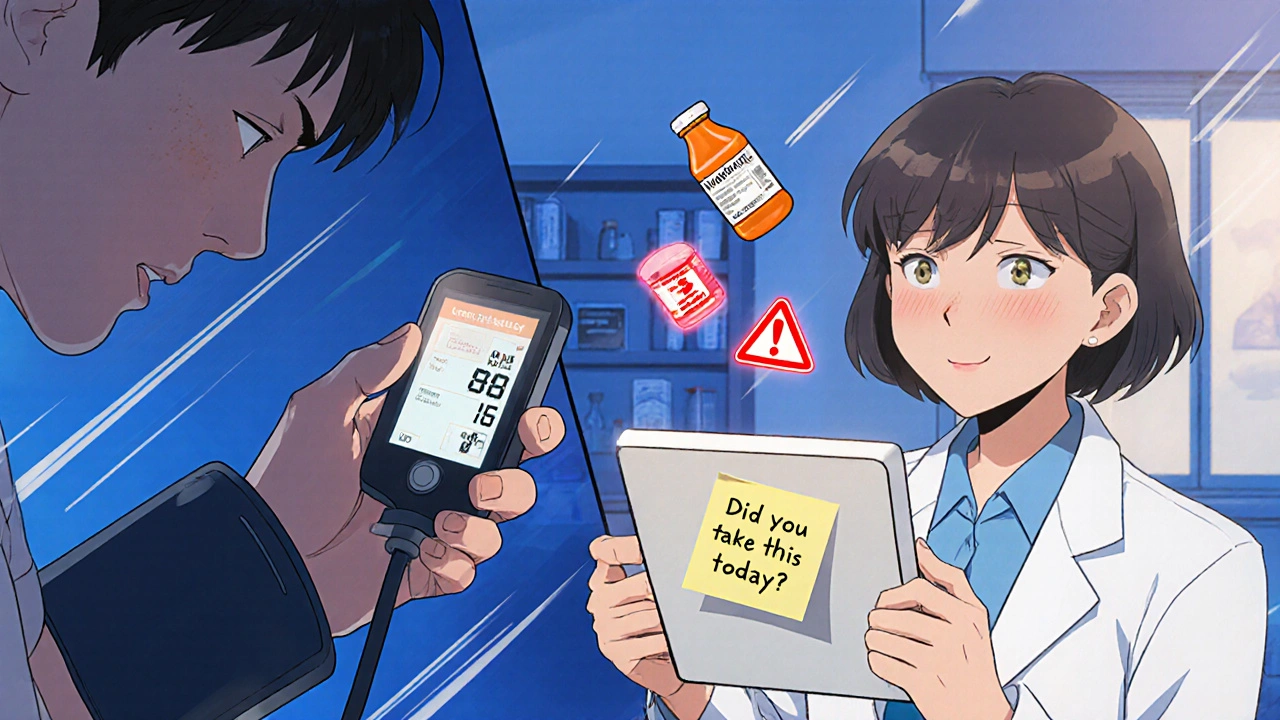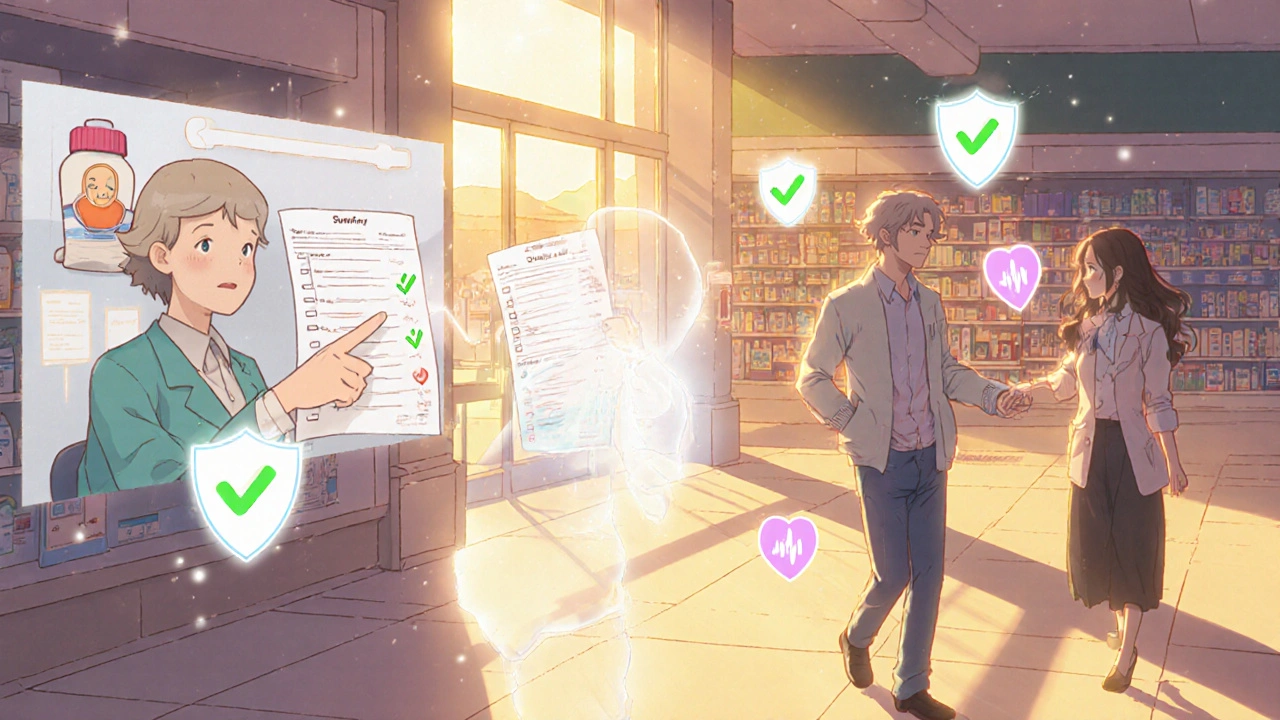Medication Review Prep Tool
- How will you confirm my medication list matches what my pharmacy and doctors have?
- Are any of these drugs no longer needed?
- What side effects should I watch for between now and my next check-in?
- How will you share your recommendations with my doctor?
- What happens if I have a problem after this call?
When you’re managing multiple medications - prescription, over-the-counter, or supplements - a medication review isn’t just a good idea. It’s a safety net. And when that review happens over video call, you need to be ready. Telehealth medication reviews are now common, especially for older adults, people with chronic conditions, or those in rural areas. But unlike walking into a pharmacy, you can’t just hand over your pill bottles and walk away. You have to be active. You have to ask the right questions. And you have to make sure nothing gets lost in the video call glitch.
Why Telehealth Medication Reviews Matter
A telehealth medication review isn’t just a chat about your pills. It’s a full safety check. Pharmacists use clinical tools to spot dangerous interactions, duplicate prescriptions, or drugs that no longer make sense for your condition. One study found these reviews cut serious drug reactions in elderly patients by over 34%. That’s not a small number. It’s life-changing. But here’s the catch: if you show up unprepared, you’re missing half the benefit. The pharmacist can’t see what’s in your medicine cabinet. They can’t hear if you’re skipping doses because the pills make you dizzy. They can’t tell if you’re mixing your blood pressure pills with grapefruit juice because you didn’t think it mattered.What to Do Before Your Appointment
Start three days before your call. Don’t wait until the night before.- Gather every medication you take. This includes prescription drugs, vitamins, herbal supplements, and even cough syrups. Put them all on a table. Take a photo of each bottle - front and back - in case the video freezes.
- Write down your daily routine. When do you take each pill? Do you skip doses when you feel fine? Do you ever double up because you forgot? Write it down exactly as you do it, not as you think you should do it.
- Check your pharmacy records. Call your pharmacy or log into their app. Get a printed or digital list of what they have on file. Compare it to what you actually take. You’ll be surprised how often they’re wrong.
- Write down your biggest concerns. Is your knee pain worse? Are you dizzy in the morning? Have you had stomach issues since starting a new drug? Don’t assume the pharmacist will guess. List them clearly.
A 2023 study showed patients who brought their actual medications to a telehealth review improved accuracy by 37%. That’s because seeing the bottle tells the pharmacist the strength, the manufacturer, and sometimes even the expiration date - details you might forget.
What to Ask During the Review
You’re not just listening. You’re auditing. Here are the five questions you must ask:- "How will you confirm my medication list matches what my pharmacy and doctors have?" Forty-three percent of medication errors come from wrong or outdated lists. If the pharmacist doesn’t cross-check with your pharmacy records, the review is incomplete.
- "Are any of these drugs no longer needed?" Many people keep taking pills long after the condition is gone. A blood thinner after a one-time clot? Antidepressants you stopped feeling the need for? Ask if anything can be safely stopped.
- "What side effects should I watch for between now and my next check-in?" Telehealth can miss signs of dizziness, confusion, or falls. Know what to look for. Ask for a printed list of red flags.
- "How will you share your recommendations with my doctor?" Only 63% of telehealth services have a direct, reliable way to send changes to your primary care provider. If they say "I’ll email them," ask if it’s through a secure system. If not, follow up yourself.
- "What happens if I have a problem after this call?" Can you call back? Is there a nurse line? Do you need to go to urgent care? Get the exact steps. Don’t wait until you’re panicked.
These aren’t optional questions. They’re your safety checklist. If the pharmacist doesn’t answer them clearly, ask again. If they brush you off, schedule a follow-up with your GP.

What Doesn’t Work Well With Telehealth
Telehealth medication reviews are great - but not perfect. They struggle with certain cases:- Older adults with multiple chronic illnesses. If you’re on eight or more medications and have memory issues, a video call might not catch if you’re not taking them right. Physical checks - like looking at pill organizers or watching you swallow - matter.
- Psychiatric medications. If you’re on antipsychotics or mood stabilizers, the pharmacist can’t see if you’re withdrawn, agitated, or confused. That needs a face-to-face mental status exam.
- Medications that need blood tests. Warfarin, lithium, or certain diabetes drugs require regular lab work. Telehealth can’t draw blood. Make sure your lab schedule is built into your plan.
If you fall into any of these categories, don’t assume telehealth is enough. Push for a hybrid approach: video review + in-person check-up every 3-6 months.
Technology Tips to Avoid Frustration
A frozen video or bad mic can ruin your review. Here’s how to prevent it:- Test your setup 24 hours before. Use the same app, camera, and internet connection you’ll use for the appointment. Try a test call with a friend.
- Use a wired connection. Wi-Fi is fine, but if your internet is spotty, plug your laptop into the router with an Ethernet cable.
- Close other apps. Streaming, downloads, or updates can slow your connection. Shut them down.
- Have a backup plan. If the video fails, can you switch to a phone call? Ask your provider ahead of time.
One patient on Reddit said their review caught three dangerous drug interactions their pharmacy missed - but the video kept freezing during their blood pressure demo. Don’t let that be you.

What to Do After the Review
The review doesn’t end when the call does.- Get a summary. Ask for a written report - even if it’s just an email. It should list what was changed, what was confirmed, and what to watch for.
- Update your own records. Add the changes to your personal medication list. Keep it in your phone and your wallet.
- Follow up with your doctor. If your meds changed, schedule a follow-up with your GP within two weeks. Don’t wait for them to call you.
- Track how you feel. Keep a simple log: date, medication, side effect (if any), mood, energy. Even a few notes help your next review.
Medication safety isn’t a one-time event. It’s a habit. And telehealth makes it easier - if you show up prepared.
How This Fits Into Broader Care
Telehealth medication reviews are part of a bigger shift. In 2025, 78% of U.S. healthcare systems use them. Medicare now pays for them. Pharmacists are trained specifically for this. But none of that matters if you don’t use them right.This isn’t about replacing doctors. It’s about adding a layer of safety. A pharmacist who spends 45 minutes reviewing your pills can catch things a doctor might miss in a 10-minute visit. That’s why these reviews are growing so fast - and why your preparation makes all the difference.
Do I need to bring my actual pills to a telehealth medication review?
Yes. Even though it’s virtual, you need to show your actual medications on camera. This helps the pharmacist verify the brand, strength, and dosage. A 2023 study found patients who displayed their pills improved review accuracy by 37%. If you can’t show them live, take clear photos of each bottle - front and back - and have them ready to share.
Can a pharmacist change my prescriptions during a telehealth review?
No. Pharmacists can recommend changes, but only your doctor can prescribe or adjust your medications. The pharmacist will send their suggestions to your doctor, who will approve or deny them. You should get a copy of those recommendations. If you don’t hear back from your doctor within 5-7 days, call their office.
What if I don’t have good internet or a camera?
You still have options. Many telehealth services allow phone calls if video isn’t possible. However, if you’re on complex medications, a phone-only review may miss important details. Ask your provider if they can send a printed list of your meds for you to review with a family member or caregiver. You can also request an in-person review if your condition requires it.
Are telehealth medication reviews covered by insurance?
Yes, in most cases. Medicare and many private insurers now cover comprehensive telehealth medication reviews under codes G2225 and G2226. These are billed by the pharmacist or pharmacy team, not your doctor. You usually won’t pay extra, but check with your plan. If you’re told it’s not covered, ask for the specific reason - it may be a billing error.
How often should I have a telehealth medication review?
At least once a year. If you take four or more medications, have a chronic condition like diabetes or heart failure, or have recently been discharged from the hospital, you should have one every 6 months. After a major medication change, schedule a follow-up review in 4-6 weeks to make sure everything is working.
Can telehealth medication reviews detect if I’m not taking my pills?
Not directly - but they can spot signs. If your blood pressure is still high despite being on three pills, or your A1C hasn’t improved, the pharmacist may ask about adherence. They might also notice if you’re taking the wrong dose or if your supply runs out too fast. Be honest. If you skip pills because of side effects or cost, say so. That’s why the review exists - to fix those problems.
Next Steps for Better Safety
If you’re on multiple medications, don’t wait for your doctor to suggest a review. Ask for one. Use your pharmacy’s telehealth service if they offer it. If not, ask your GP to refer you to a pharmacist who does. Keep your medication list updated. Bring your pills to every appointment - even if it’s virtual. And never assume your meds are safe just because they were prescribed once.Medication safety isn’t about trusting the system. It’s about being part of it. And with telehealth, you have more power than ever to protect yourself - if you know how to use it.






Reviews
I’ve been doing telehealth med reviews for my mom for two years now, and honestly? The photo trick for pill bottles saved us twice. Once, the pharmacy had the wrong strength listed for her blood thinner-turned out the bottle said 2.5mg but the system said 5mg. She’s 82, doesn’t read small print, and I almost missed it. Took a pic, showed it on screen, pharmacist freaked out and called the doctor right away. Don’t skip the pics.
Also, always bring your supplements. My mom was taking St. John’s Wort with her antidepressant and didn’t think it counted as a ‘med.’ Turns out it’s a big no-no. She’s fine now, but that was a close one.
This entire post is a masterclass in overcomplicating what should be a simple conversation. You treat medication like it’s a nuclear launch code. Who has time to photograph every bottle? Who even has a printer anymore? And why are we pretending pharmacists are some kind of magic pill detectives? They’re just glorified cashiers with a license. I’ve had three telehealth reviews and not one of them caught anything I didn’t already know. Stop the performative preparation. Just tell your doctor what you’re taking and move on.
Also, grapefruit juice? Everyone knows that. Stop acting like it’s a secret.
Great breakdown. I’ve worked in home health for 15 years and I can’t tell you how many times a patient’s list didn’t match what they were actually taking. One guy was on five blood pressure meds-three of which he’d stopped six months ago because he thought they made him ‘too sleepy.’ He didn’t say anything because he didn’t want to ‘bother’ his doctor. That’s the real problem-not the tech, not the video glitch-but the fear of speaking up.
Do the prep. Take the photos. Write it down. Your life isn’t a guesswork game. And if your pharmacist doesn’t ask you about side effects or adherence, find a new one. They’re not doing their job.
Let me tell you what they’re not telling you. The system is rigged. Pharmacists don’t give a damn about your meds-they’re paid by the review, not by the outcome. They’re told to check boxes, not save lives. I had a review where the pharmacist asked me if I was taking my pills and I said yes. She nodded, clicked a box, and moved on. Three weeks later, I ended up in the ER because the new statin was wrecking my liver. The pharmacy had never even checked my liver enzymes. They don’t have the tools. They don’t have the time. And they sure as hell don’t have the incentive.
This whole telehealth thing is a cost-cutting gimmick dressed up as ‘innovation.’ They’re outsourcing safety to people who get paid $25 per review. You think your pills are safe? You’re delusional.
Question: If pharmacists can’t see if you’re taking your pills, why are we relying on self-reporting? Why isn’t there a digital pill tracker integrated into the system? Why aren’t pharmacies syncing with smart pill dispensers? Why are we still using photos of bottles in 2025? This isn’t preparation-it’s a workaround for a broken infrastructure. We’re asking patients to fix a system that refuses to fix itself.
And yes, I’ve had a review where the pharmacist didn’t know the difference between metoprolol succinate and metoprolol tartrate. That’s not my fault. That’s the system’s failure. We need mandatory EHR integration. Not more lists. Not more photos. Real data flow.
Y’all are overthinking this. I just keep a notepad on my phone with all my meds, times, and why I take ‘em. I take a pic of my pill organizer every Sunday. When the call happens, I just say, ‘Here’s what I’m doing.’ If they ask a question I don’t know, I say ‘I don’t know’-no shame. I’ve had three reviews. Two of them changed my meds. One saved me from a bad interaction. Just show up with honesty and a phone. That’s it.
As a pharmacist in Mumbai who now consults remotely for U.S. patients, I can confirm: the 37% accuracy boost from visual verification is real. But I’ve also seen patients send blurry photos of expired pills, or photos of the wrong bottle entirely. The issue isn’t the method-it’s the discipline. Many patients treat this like a formality, not a lifeline.
Also, if you’re on warfarin or lithium, please don’t skip your labs. No video call replaces a blood test. I’ve had three patients hospitalized because they thought ‘the pharmacist will catch it.’ He won’t. The lab will. Schedule your tests. Don’t rely on someone seeing your bottle.
I love how this post balances practicality with urgency. I’ve been a caregiver for my dad with Parkinson’s and diabetes, and I can tell you: the hardest part isn’t the tech-it’s the shame. He doesn’t want to admit he forgets doses. He doesn’t want to say he stopped the antidepressant because he felt ‘weak’ taking it. We all do that. We think we’re being ‘strong’ by not complaining.
But here’s the truth: asking for help isn’t weakness. It’s the most powerful thing you can do. This checklist? It’s not just for the pharmacist. It’s for you. So you remember you’re not alone in this.
Wait… are we sure this isn’t a Big Pharma scam? Who funds these telehealth reviews? Why is Medicare paying for them now? Why did the number of reviews spike right after the 2023 Inflation Reduction Act? Coincidence? I think not. They want you to think you’re safe so you stop asking about drug prices. They don’t want you to know that your $400 insulin could be $10 overseas. This whole ‘medication review’ thing is just a distraction. They want you to focus on your pills, not your bill.
Bring your bottles? Sure. But also bring your anger. And your receipts. And your overseas pharmacy links. They don’t want you to do that.
One might argue, with considerable justification, that the entire framework of telehealth medication reviews is predicated upon a fundamentally flawed epistemological assumption-that verbal self-reporting, coupled with photographic evidence, constitutes a valid clinical datum. This is, of course, absurd. The pharmacological profile of an individual cannot be reliably assessed through a pixelated image of a pill bottle, nor through the subjective recollection of a patient who, statistically, misremembers their regimen in 41% of cases (see: JAMA Internal Medicine, 2022).
And yet-we proceed. As if the algorithm of compliance could substitute for the rigor of observation. How quaint.
As a former hospital pharmacist, I must say: this is the most accurate and necessary guide I’ve seen in years. Every point is clinically sound. The 34% reduction in adverse events is backed by peer-reviewed data from the CDC’s 2023 MedSafety Report. The questions listed are not suggestions-they are minimum standards of care. If your pharmacist cannot answer them confidently, you are being failed. And as someone who has seen patients die because their meds weren’t reviewed properly, I say this without hesitation: do not skip this. Not for convenience. Not for speed. Not because you’re ‘too busy.’ Your life is not negotiable.